Taxes can be complicated, and one of the lesser-known but crucial aspects of the U.S. tax system is the Alternative Minimum Tax (AMT). Designed to ensure that high-income earners pay their fair share, the AMT is a separate tax calculation that eliminates certain deductions and tax breaks available under the regular tax system. If applicable, taxpayers must calculate their tax liability under both the standard rules and AMT rules—ultimately paying the higher amount. While originally created to prevent wealthy individuals from avoiding taxes, AMT can unexpectedly impact middle-income earners, especially those with incentive stock options, large capital gains, or high state tax deductions. Understanding how the AMT works, who it applies to, and why it exists is essential for tax planning and avoiding surprises during tax season.
What is the Alternative Minimum Tax (AMT)?
The Alternative Minimum Tax (AMT) is a parallel tax system in the United States designed to ensure that high-income taxpayers pay at least a minimum level of tax, regardless of deductions, exemptions, or credits they may otherwise claim. It operates alongside the regular income tax system, requiring taxpayers to calculate their liability under both methods and pay the higher amount. The AMT recalculates taxable income by adding back certain tax preference items, such as state and local tax deductions, incentive stock options, and certain investment-related deductions. It applies two tax rates—26% and 28%—to the Alternative Minimum Taxable Income (AMTI) after subtracting the AMT exemption. While originally intended to prevent wealthy individuals from avoiding taxes through excessive deductions, changes in tax laws have reduced its impact on middle-income taxpayers. However, those with significant capital gains, large deductions, or certain types of income may still be subject to AMT.
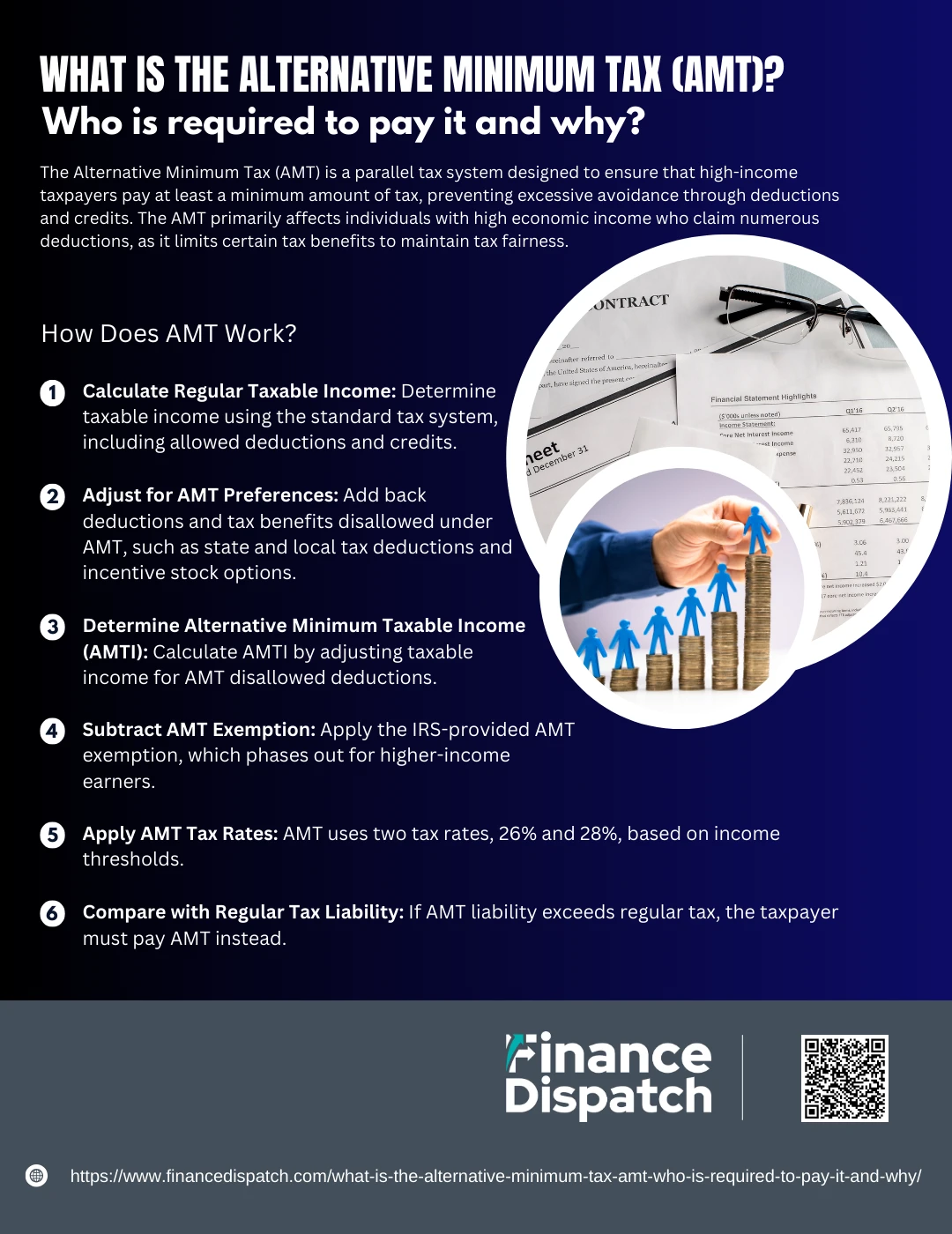 How Does AMT Work?
How Does AMT Work?
The Alternative Minimum Tax (AMT) is a separate tax system designed to prevent high-income individuals from using deductions and credits to significantly reduce or eliminate their tax liability. It operates parallel to the regular tax system, requiring taxpayers to calculate their taxes under both methods and pay whichever results in a higher amount. Unlike the regular tax system, which allows a wide range of deductions, AMT disallows or limits many tax breaks, such as state and local tax deductions, certain business expenses, and depreciation. It also applies different tax rates—26% and 28%—depending on income levels. Understanding how AMT is calculated can help taxpayers anticipate their potential tax obligations and avoid surprises when filing their returns.
1. Calculate Regular Taxable Income
Begin by determining taxable income under the standard tax system, applying deductions and credits as allowed under normal IRS rules.
2. Adjust for AMT Preferences
AMT requires taxpayers to add back certain deductions and tax benefits that are allowed under the regular tax system but not under AMT. These include state and local tax deductions, incentive stock options, private activity bond interest, and accelerated depreciation adjustments.
3. Determine Alternative Minimum Taxable Income (AMTI)
After adding back these disallowed deductions, the taxpayer arrives at their Alternative Minimum Taxable Income (AMTI), which serves as the basis for AMT calculations.
4. Subtract AMT Exemption
The IRS provides an AMT exemption to reduce the AMTI, which varies based on filing status. For 2024, the exemption amounts are $85,700 for single filers and $133,300 for married joint filers. However, this exemption phases out once income exceeds a certain threshold, which means higher-income earners lose part or all of their exemption.
5. Apply AMT Tax Rates
Unlike the regular tax system, which has multiple tax brackets, AMT has only two tax rates: 26% and 28%. The 26% rate applies to income up to a certain level ($232,600 in 2024), and any income above this threshold is taxed at 28%.
6. Compare with Regular Tax Liability
Finally, the AMT liability is compared to the regular tax liability. If the AMT amount is higher than the regular tax, the taxpayer must pay the AMT instead. If the regular tax is higher, no AMT is owed.
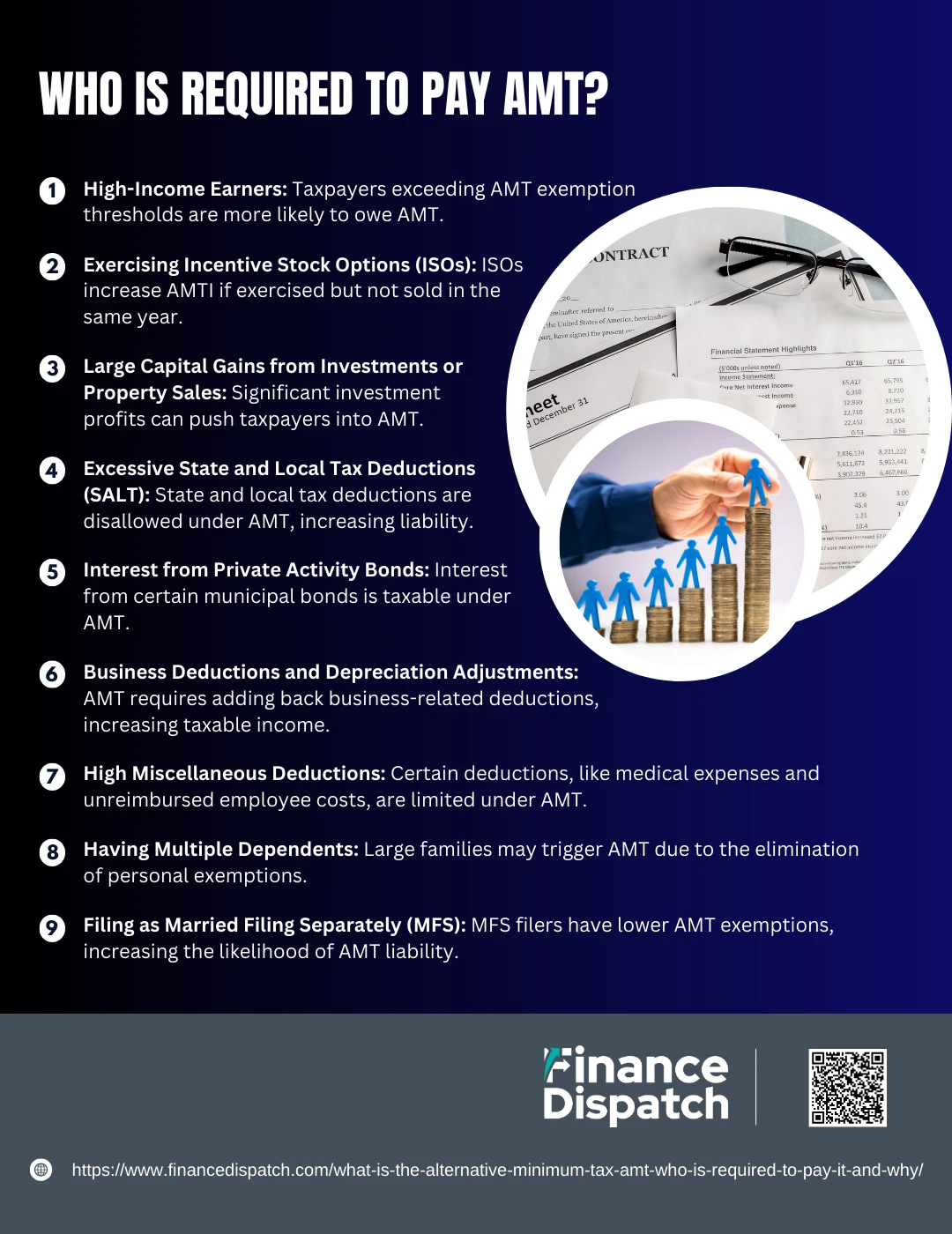 Who is required to Pay AMT?
Who is required to Pay AMT?
The Alternative Minimum Tax (AMT) primarily affects high-income earners and individuals who claim significant deductions, receive tax-exempt income, or engage in certain financial activities, such as exercising incentive stock options (ISOs) or realizing large capital gains. Unlike the regular tax system, which allows a variety of deductions and credits, the AMT recalculates taxable income by adding back certain tax preference items, which can increase a taxpayer’s overall tax liability. Since AMT applies a flat tax rate of 26% or 28% after exemptions, taxpayers with high adjusted gross incomes may find themselves subject to AMT, even if they qualify for deductions under the standard tax system. Below are the most common scenarios in which AMT liability arises.
Common Triggers for AMT Liability
1. High-Income Earners
Individuals with income exceeding AMT exemption thresholds may be required to pay AMT. In 2024, the exemption is $85,700 for single filers and $133,300 for married joint filers. However, once income reaches the phase-out threshold ($609,350 for single filers and $1,218,700 for joint filers), the exemption gradually reduces, making AMT more likely.
2. Exercising Incentive Stock Options (ISOs)
Employees who exercise ISOs but do not sell the stock in the same tax year must report the difference between the grant price and fair market value as taxable income under AMT rules. This adjustment can significantly increase their alternative minimum taxable income (AMTI), triggering AMT.
3. Large Capital Gains from Investments or Property Sales
Profits from selling stocks, businesses, or real estate can push a taxpayer’s income into AMT territory. Even though long-term capital gains are taxed at lower preferential rates under regular tax rules, large capital gains can indirectly phase out the AMT exemption, increasing AMT liability.
4. Excessive State and Local Tax Deductions (SALT)
Under the regular tax system, taxpayers can deduct state and local taxes, including property taxes, but these deductions are disallowed under AMT rules. High-income earners in states with high income tax rates, such as California, New York, and New Jersey, are particularly at risk.
5. Interest from Private Activity Bonds
Normally, municipal bond interest is tax-exempt, but AMT includes interest earned from private activity bonds in taxable income. Taxpayers with substantial investments in these bonds may see an increase in AMT liability.
6. Business Deductions and Depreciation Adjustments
Business owners and self-employed individuals who claim accelerated depreciation, intangible drilling costs, depletion deductions, or passive activity losses may need to add back these deductions under AMT calculations, potentially increasing their taxable income.
7. High Miscellaneous Deductions
Deductions for medical expenses, home mortgage interest (on loans not used to buy, build, or improve a home), and unreimbursed employee expenses may be limited or entirely disallowed under AMT, increasing tax liability.
8. Having Multiple Dependents
Taxpayers with several children or dependents can be more likely to trigger AMT. This is because personal exemptions were eliminated under AMT before the Tax Cuts and Jobs Act (TCJA) of 2017, making large families more vulnerable to AMT liability.
9. Filing as Married Filing Separately (MFS)
AMT rules are stricter for taxpayers who file separately from their spouse. The AMT exemption for married individuals filing separately is significantly lower than for those filing jointly, increasing the likelihood of AMT liability.
Why Was AMT Created?
The Alternative Minimum Tax (AMT) was introduced in 1969 to ensure that high-income individuals paid their fair share of taxes, even if they qualified for numerous deductions and credits under the standard tax system. The IRS discovered that 155 wealthy taxpayers with incomes over $200,000 had paid no federal income tax in 1966, primarily due to the extensive use of deductions and tax shelters. To prevent such tax avoidance, Congress established the AMT as a parallel tax system that recalculates taxable income by eliminating certain deductions and tax preferences. Over time, the AMT began affecting a larger number of taxpayers due to inflation and rising incomes, particularly middle-income households in high-tax states. In 2012, Congress indexed the AMT exemption amounts to inflation to prevent unintentional “bracket creep.” The Tax Cuts and Jobs Act (TCJA) of 2017 further reduced AMT’s impact by increasing exemption thresholds, significantly limiting the number of taxpayers subject to it. However, if TCJA provisions expire in 2025, AMT could once again affect millions of taxpayers, highlighting its ongoing role in preventing tax avoidance while raising concerns about its fairness and effectiveness.
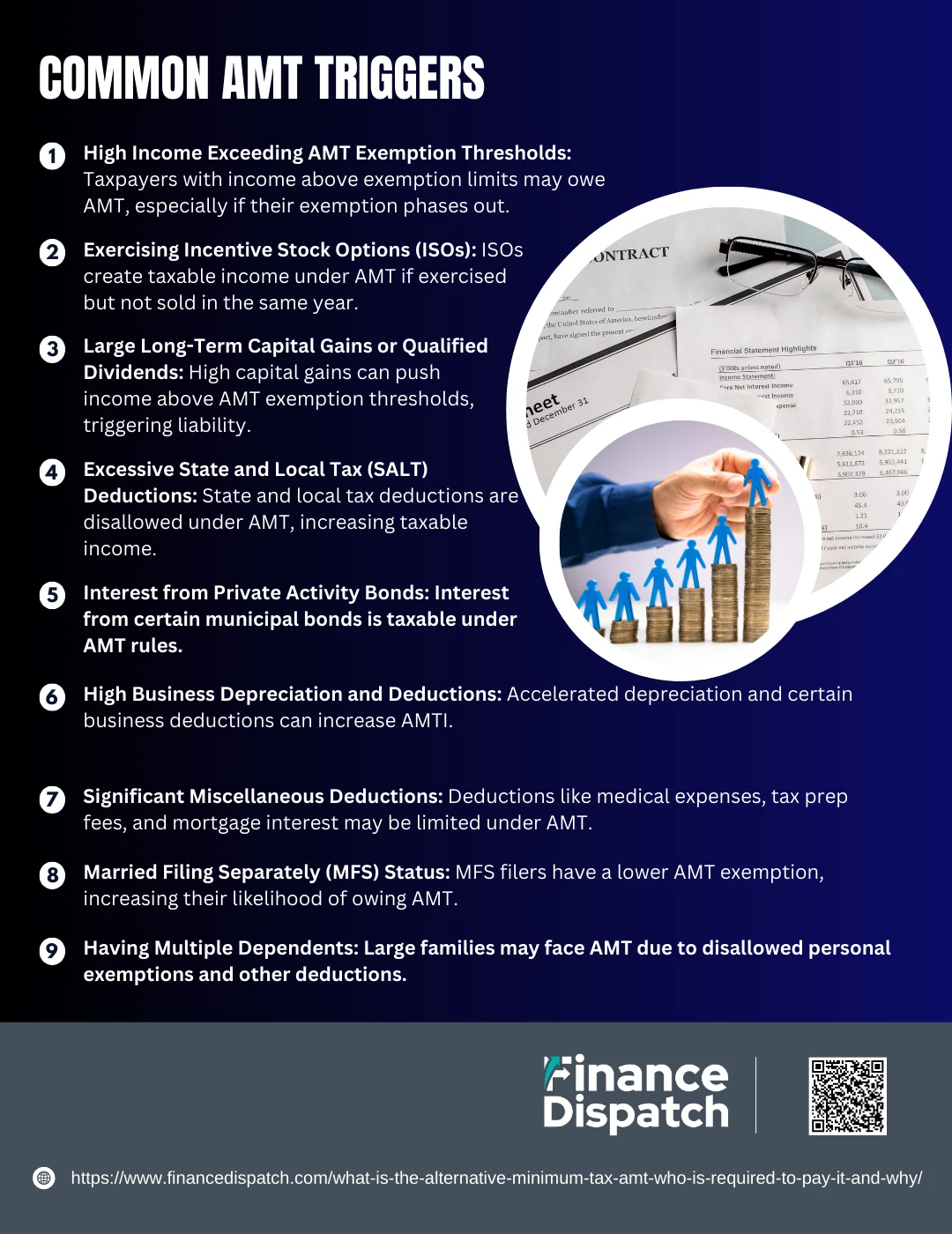 Common AMT Triggers
Common AMT Triggers
The Alternative Minimum Tax (AMT) is triggered when certain tax preferences or deductions cause a taxpayer’s Alternative Minimum Taxable Income (AMTI) to exceed the allowable AMT exemption. Since AMT was designed to prevent high-income individuals from significantly reducing their tax liability through deductions and tax credits, taxpayers with large itemized deductions, capital gains, or certain types of investment income are more likely to be affected. While AMT primarily targets high earners, some middle-income taxpayers in high-tax states may also be impacted. Below are the most common scenarios that trigger AMT liability.
Key Triggers for AMT Liability
1. High Income Exceeding AMT Exemption Thresholds
Taxpayers with income above the AMT exemption amount ($85,700 for single filers and $133,300 for married joint filers in 2024) may be required to pay AMT. If income exceeds the phase-out threshold ($609,350 for single filers and $1,218,700 for married joint filers), the exemption starts reducing, further increasing AMT liability.
2. Exercising Incentive Stock Options (ISOs)
Employees who exercise ISOs but do not sell the stock in the same year must report the difference between the grant price and the fair market value as AMT taxable income, even though it is not taxed under the regular tax system. This can create a large tax bill if the stock value is significantly higher than the purchase price.
3. Large Long-Term Capital Gains or Qualified Dividends
While long-term capital gains and qualified dividends are taxed at lower preferential rates under the regular tax system, large capital gains can push a taxpayer’s income above the AMT exemption threshold. This can lead to AMT liability even though the gains themselves are still taxed at favorable rates.
4. Excessive State and Local Tax (SALT) Deductions
Under the regular tax system, taxpayers can deduct state and local income taxes, sales taxes, and property taxes, but these deductions are disallowed under AMT. This makes AMT particularly burdensome for taxpayers in high-tax states like California, New York, New Jersey, and Illinois.
5. Interest from Private Activity Bonds
Certain municipal bonds, known as private activity bonds, generate interest that is tax-free under the regular tax system but taxable under AMT. Taxpayers with large investments in these bonds may find themselves subject to AMT.
6. High Business Depreciation and Deductions
Business owners and self-employed individuals who claim accelerated depreciation, depletion deductions, or passive activity losses may have to add these deductions back under AMT rules, increasing their taxable income.
7. Significant Miscellaneous Deductions
AMT disallows or limits certain itemized deductions that are allowed under the regular tax system, such as:
- Medical expenses (above a certain threshold)
- Unreimbursed employee expenses (such as travel, home office costs, and union dues)
- Tax preparation fees
- Home mortgage interest (if the loan was not used to buy, build, or improve a home)
8. Married Filing Separately (MFS) Status
Taxpayers who file as married filing separately (MFS) face a lower AMT exemption threshold and are more likely to be subject to AMT than those filing jointly. This can create unexpected tax burdens for couples who file separately for strategic reasons.
9. Having Multiple Dependents
Prior to the Tax Cuts and Jobs Act (TCJA) of 2017, taxpayers who claimed multiple personal exemptions for dependents were more likely to trigger AMT. While TCJA eliminated personal exemptions, large families may still experience AMT liability due to other itemized deductions and tax credits.
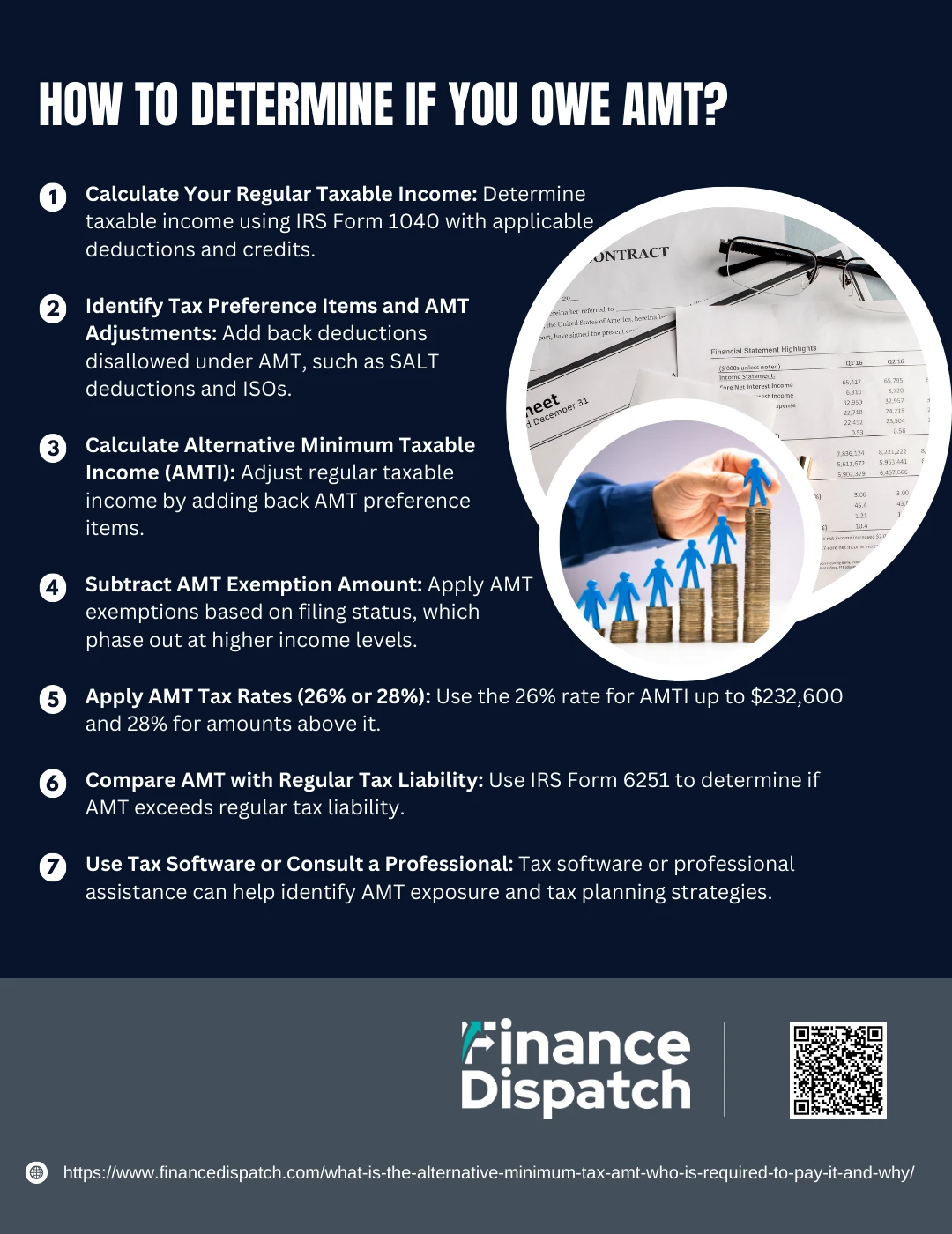 How to Determine if You Owe AMT?
How to Determine if You Owe AMT?
The Alternative Minimum Tax (AMT) applies to certain taxpayers who have high income or claim specific deductions and tax breaks that are disallowed under AMT rules. Since AMT calculations follow a separate set of tax rules, taxpayers must determine whether they owe AMT by comparing their regular tax liability with their AMT liability. If the AMT amount is higher, they must pay the difference. To avoid surprises at tax time, it’s important to understand the step-by-step process of determining AMT liability.
Steps to Determine if You Owe AMT
1. Calculate Your Regular Taxable Income
Start by computing your taxable income under the regular tax system using IRS Form 1040. Include all sources of income, deductions, and applicable tax credits.
2. Identify Tax Preference Items and AMT Adjustments
Certain deductions and tax-exempt income that lower your taxable income under the regular tax system may need to be added back for AMT calculations. These include:
-
- State and local tax (SALT) deductions
- Mortgage interest deductions (on loans not used for home purchase or improvement)
- Investment interest from private activity bonds
- Accelerated depreciation deductions
- Exercise of incentive stock options (ISOs)
3. Calculate Alternative Minimum Taxable Income (AMTI)
Add back AMT preference items and adjustments to your regular taxable income to arrive at your Alternative Minimum Taxable Income (AMTI).
4. Subtract AMT Exemption Amount
The IRS provides an AMT exemption to reduce AMTI, based on filing status. For 2024, the exemptions are:
-
- $85,700 for single filers
- $133,300 for married joint filers
- $66,650 for married filing separately
However, once income exceeds the phase-out threshold ($609,350 for single filers and $1,218,700 for joint filers), the exemption starts reducing.
5. Apply AMT Tax Rates (26% or 28%)
After subtracting the exemption, apply the AMT tax rates:
-
- 26% for AMTI up to $232,600 (2024 figures)
- 28% for AMTI above $232,600
6. Compare AMT with Regular Tax Liability
Use IRS Form 6251 to compare the total AMT amount with your regular tax liability. If the AMT liability is higher than your regular tax, you must pay the AMT amount instead.
7. Use Tax Software or Consult a Professional
Since AMT calculations can be complex, most tax software programs automatically check for AMT liability. If your financial situation is complicated, consider consulting a tax professional for AMT planning and mitigation strategies.
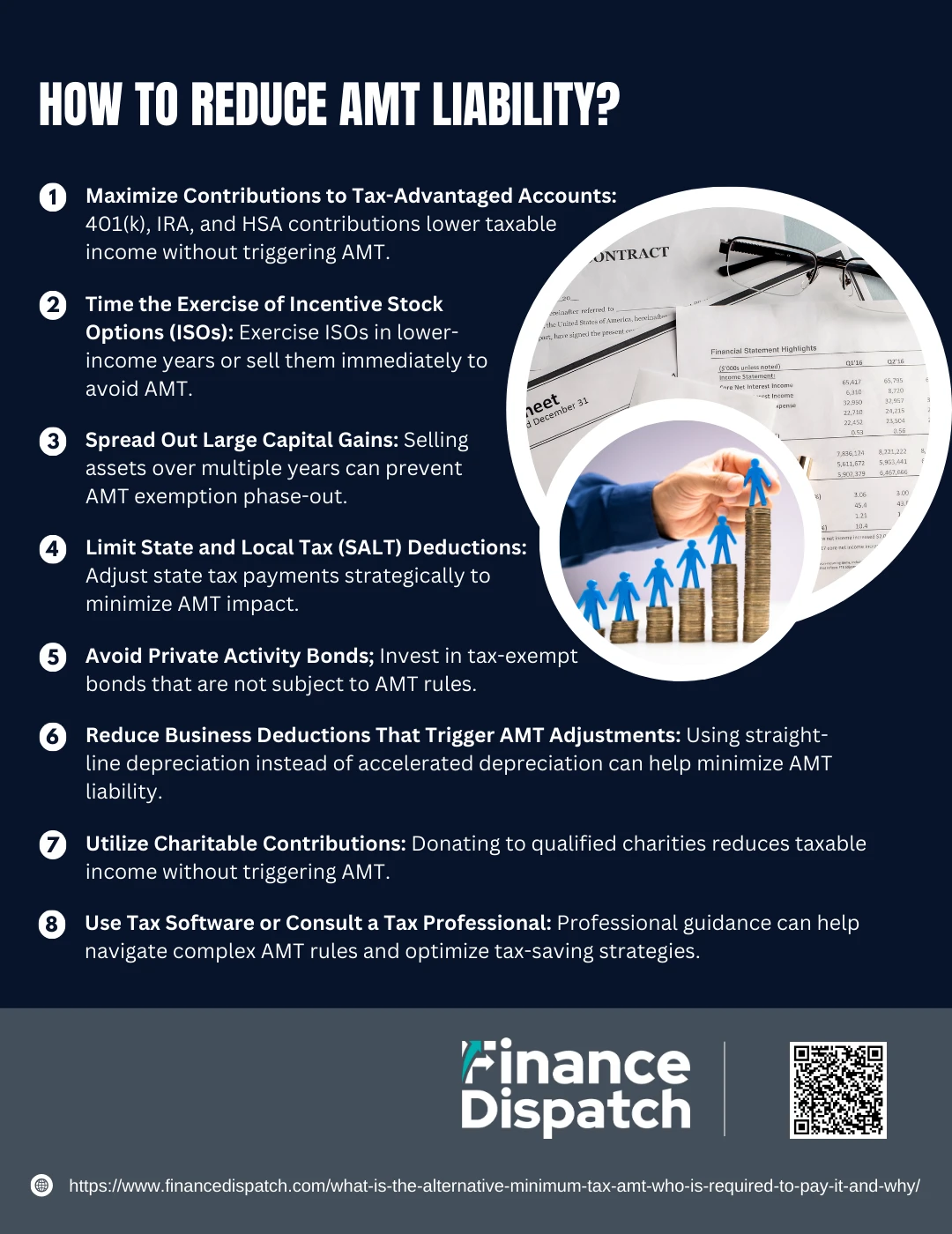 How to Reduce AMT Liability?
How to Reduce AMT Liability?
If you find yourself subject to the Alternative Minimum Tax (AMT), there are strategies you can use to minimize your tax liability and avoid paying more than necessary. Since AMT calculations disallow certain deductions and tax credits available under the regular tax system, reducing AMT liability requires careful tax planning. The key is to lower your Alternative Minimum Taxable Income (AMTI) by managing deductions, timing income, and maximizing tax-efficient investment strategies. Below are some effective ways to reduce AMT liability.
Strategies to Reduce AMT Liability
1. Maximize Contributions to Tax-Advantaged Accounts
Contribute the maximum allowed to 401(k)s, IRAs, and Health Savings Accounts (HSAs) to lower your taxable income. These contributions reduce regular and AMT taxable income without triggering AMT adjustments.
2. Time the Exercise of Incentive Stock Options (ISOs)
If you hold ISOs, consider exercising them in years when your overall income is lower to avoid a large AMT adjustment. Alternatively, sell the stock in the same year you exercise to prevent the AMT adjustment from applying.
3. Spread Out Large Capital Gains
If you plan to sell stocks, real estate, or other assets with large gains, spread the sales over multiple years to prevent pushing your income above the AMT exemption phase-out threshold.
4. Limit State and Local Tax (SALT) Deductions
Since AMT disallows state and local tax deductions, consider delaying state tax payments to another year or bundling them in years when AMT is not applicable.
5. Avoid Private Activity Bonds
Interest from certain municipal bonds (private activity bonds) is taxable under AMT rules. Invest in tax-exempt bonds that are not subject to AMT to reduce your taxable income.
6. Reduce Business Deductions That Trigger AMT Adjustments
Business owners should be cautious with deductions related to accelerated depreciation, depletion, and passive activity losses, as they can increase AMT liability. Using straight-line depreciation instead of accelerated depreciation may help minimize AMT adjustments.
7. Utilize Charitable Contributions
Donations to qualified charities reduce taxable income without triggering AMT adjustments. Consider donating appreciated assets instead of cash to maximize deductions without increasing AMTI.
8. Use Tax Software or Consult a Tax Professional
Since AMT calculations can be complex, using tax software or working with a tax professional can help you identify potential AMT triggers and implement tax-saving strategies.
Future of AMT and Potential Changes in 2025
The Alternative Minimum Tax (AMT) underwent significant modifications under the Tax Cuts and Jobs Act (TCJA) of 2017, which raised AMT exemption amounts and phase-out thresholds, dramatically reducing the number of taxpayers affected. However, these changes are set to expire at the end of 2025, unless Congress extends them or passes new tax legislation. If the TCJA provisions sunset, AMT exemption amounts and phase-out thresholds will revert to pre-2018 levels, significantly increasing the number of taxpayers subject to AMT—potentially affecting millions more middle-income earners. Without legislative action, state and local tax (SALT) deductions, depreciation adjustments, and incentive stock option exercises could once again trigger AMT for a broader range of taxpayers. Additionally, the AMT credit rules may change, impacting those who have carried forward AMT credits from previous years. As tax policy discussions continue, it remains uncertain whether Congress will extend the current AMT relief or allow the pre-2018 system to return, making tax planning for 2025 and beyond more crucial than ever.
Conclusion
The Alternative Minimum Tax (AMT) was designed to ensure that high-income taxpayers pay their fair share, but its impact has evolved over time due to legislative changes. While the Tax Cuts and Jobs Act (TCJA) of 2017 significantly reduced the number of taxpayers affected, its expiration in 2025 could bring back AMT liabilities for millions of individuals, especially those with high deductions, capital gains, or incentive stock options. Understanding how AMT works, what triggers it, and strategies to minimize its impact is essential for effective tax planning. Whether you are currently subject to AMT or may be affected in the future, staying informed and consulting a tax professional can help you navigate the complexities of AMT and reduce potential tax burdens.



